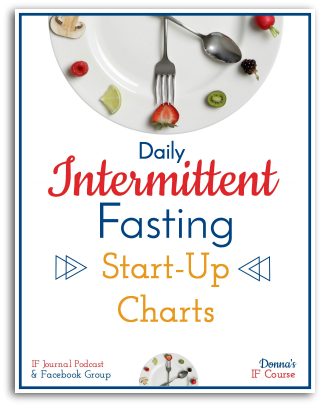For optimal viewing on a mobile device, tilt your device to landscape mode.
5 Ways to Start Daily Intermittent Fasting--Hours and Options
#1
Cold Turkey–Regardless of Plan
Whether your end goal is OMAD (One Meal a Day) or a more conservative 16 hour fasting window (also known as 16:8–16 hours of fasting and 8 hours of eating), you might be the type of person who doesn’t want training wheels, fat bombs, or incrementality to get started. Maybe you just want to GO—and not look back. If this is you and you are going to do a shorter fasting window of say 14-16 hours, you can simply look at your schedule and cut out your evening snack, breakfast, and mid-day snack and choose an 8-10 hour eating window of noon to eight or whatever suits your time period. You might be a little hungry going to bed at first and it might be difficult to work through the morning for the first week or so, but it shouldn’t be impossible for you.
If this is you and you want to end up with a short eating window of say five hours or fewer (also called 19:5, 20:4, and 21:3 protocols), cold turkey can be challenging. If you are used to eating five or six times a day (and only truly being in a “fasted” state for, say, 8 hours of sleep), it can be overwhelming to wake up and face twelve hours without food. You will want to be sure that you are super busy during your first two to four weeks of cold turkey OMAD (while you are waiting for your body to become fat adapted and have less hunger during the fast). You will also want to utilize coping and distraction techniques, such as self-talk, five second rule tips, app use, pink himalayan salt, mineral water, sparkling water, and more.
#2
Fast Start Incrementally to OMAD (One Meal a Day)
For those who are desiring the Daily Intermittent Fasting protocol of One Meal a Day (OMAD—short eating windows of between 1 and 5 hours and longer fasts of 23 to 19 hours), you may desire to get there quickly but not necessarily in one week. You want some incrementality, but you don’t want to wait eight weeks to reach your final fasting goal. Thus, the fast start means that you will reduce snacks and meals quickly–possibly one or two per week–for up to four weeks or so.
Someone following this approach will want to examine their eating schedule and consider where you want to cut first. You will likely start with eliminating your evening snack OR breakfast. This would put you at twelve to fourteen hours of fasting the first week. While it looks like a short jump from 14 to 19 fasting hours, if you are truly going for OMAD, that is not just another snack being cut–but is another full meal and can feel harder than it looks on paper! So the next week, you will cut whichever you didn’t cut the first week (either the night snack or breakfast). Then you’ll be closer to a 16 hour fast. The third week, you will be ready to push lunch out to later in the afternoon until the next week, you replace lunch with a snack/appetizer/salad later in the afternoon when you open your eating window.
#3
Training Wheels Incrementally to OMAD (One Meal a Day)
Some people are afraid of the hunger associated with Daily Intermittent Fasting. They remember their experiences with fasting blood work or working late without having a snack on them and automatically assume that the type of hunger and sometimes sick feelings that they had during those short “fasts” are the types of hunger that they will have for the rest of their lives with Daily IF. This isn’t true, but it is reasonable to think so. Some people assume they will “get used to it” better if they do the introduction to fasting slowly. For those people, a “training wheel” approach over eight weeks might be the best way to start Daily IF.
In this way, the person seeking OMAD slowly starts out simply cutting out an hour of eating on either end (or both), gradually reducing the number of eating opportunities over six to eight weeks. So the first week, you might stop eating at 8 pm and not eat breakfast until 8 am, thus doing a twelve hour fast for a week. The next week, add an hour of fasting to the evening and the morning. And continue in this way until you land in your perfect OMAD. The downfalls of this approach are that you aren’t getting fat adapted very quickly, so it really could take the entire six to eight weeks before ravenous hunger is gone. Another disadvantage is that you will probably not see weight loss in the first six weeks or so unless you are changing what you are eating during your eating window since that is a lot of time with many eating hours each day. However, just like training wheels make the new biker more comfortable during the transition to bike riding, this approach really helps many people.
#4
16:8 to 18:6 With Keto Start Up
In my experience, the people who lose weight consistently and have the most IF benefits while having a shorter fasting window (16, 17, or 18 fasting hours) seem to be those who are eating a low carb diet plan while doing Daily IF. I have never met a person or seen a testimony of someone with life-long weight issues who got to their goal weight eating anything they want for 8 hours a day (two meals). There are three potential reasons for this: (1) Consuming too many calories during a six to eight hour eating window; (2) Not getting the benefits of Appetite Correction during your eating window because you are “getting full two times”; (3) Having too much circulating glucose/glycogen stores to burn through before you get into body fat burning. With those problems, you might not go into body fat burning (become fat adapted) until closer to 16 hours or so; thus, by the time your body starts using its own stores, you are ready to eat again and refill that glycogen.
If a person wants to do 16:8, 17:7, or 18:6, they probably need to be keto during their eating window if they are looking for weight loss. (This is actually where much of today’s IF has its roots–IF/Keto together.) For the most part, a keto diet means that you will get into body fat burning way sooner than someone eating carbs (and you may stay in ketosis all the time). Thus, even a shorter fasting window of 16 hours would still yield body fat burning every day.
#5
16:8 to 18:6 Not Keto Start Up
As explained in the previous protocol, fasting for 16, 17, or 18 hours a day with a net weight loss is challenging at best. Generally speaking, this means that you are eating two meals a day and possibly one or two desserts and one or two snacks (with no other eating boundaries in place). In order for a person to lose weight eating that frequently and that amount, they probably have to put another “diet” into play, thus eliminating one of the cool aspects of Daily Intermittent Fasting. However, many people want the health benefits of IF while still not doing terribly long fasts, or they have health challenges, social situations, or other factors coming into play that make them choose a 16:8, 17:7, or 18:6 fasting protocol. For these people, they feel it is worth it add another “diet’ to IF.
Obviously, a ketogenic diet (high fat, moderate protein, low carb {20-40 grams of carbs per day}) is a great addition for someone seeking to lose weight with a longer eating window. However, there are Daily IF’ers who count calories, fat grams, or points during their eating window. There are those who eat paleo or vegetarian and within those food boundaries, their calories (or carbs) are low enough during a longer eating window to lose weight. If you desire to do a shorter fasting window/longer eating window, you will have to play around with your food choices to achieve weight loss, but it can be done. One way that people “extend” their “fasting window” beyond 16 hours during 16:8 is to eat low carb foods during the first half of their eating window (though, unless you are doing keto, don’t eat high fat or you will end up with a high fat/high calorie diet!). While you will not still be “fasting” once you start eating, you can possibly keep yourself in body fat burning longer by eating moderate protein and low carb for the first meal and snack during your eating window. Again, you will have to tinker with your eating window to see what works for your body.
Resources
1) Cold Turkey–Regardless of Plan: Ways to Make It Through the Fast: https://donnareish.com/5-
2) Fast Start Incrementally to OMAD (One Meal a Day): https://donnareish.com/
3) Training Wheels Incrementally to OMAD (One Meal a Day): https://donnareish.com/
4) 16:8 to 18:6 With Keto Start Up: https://donnareish.com/5-
5) 16:8 to 18:6 Not Keto Start Up: https://donnareish.com/5-areas-
Find ME–and Find Out More About Daily Intermittent Fasting!
(1) FB Group for Support and Daily Help
(2) Blog with all videos, articles, 5 Top Tips for IF Slideshow, and more.
(3) IF Journal Podcast at iTunes
(4) YouTube channel
Thanks for Viewing My…..
5 Tips for Daily IF Slideshow
Find More of These Weekly Slideshows here at donnareish.com
In the slideshow above are a couple of links to books I use and love. I am an affiliate for Amazon.com. If you click on the links above I will earn a small commission. Thank you for your support of this blog!










